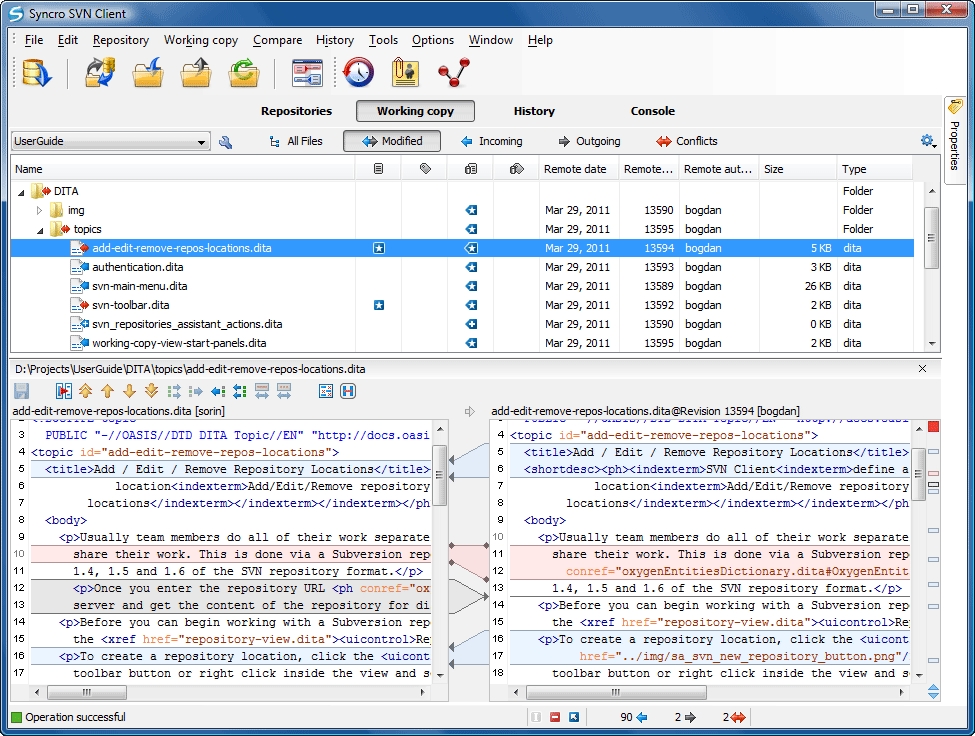
#Svn checkout update
Maybe there is some more clever ways to accomplish this seemingly trivial task as update software version number PS. The current situation is that even if I get the Continua CI to build the project, this will break the developers build routine. Is there a way to skip the Pre-Build in the build server but keep it in for the developer’s build? Otherwise the AssemblyInfo Updater action must be changed at the build server, which is not comfortable to say the least.Ģ) The MSBuild task still fails as it is not able to execute the Pre-Build assembly version update task successfully. That will allow to commit changes to the Major, Minor or Build number in the at developers checkout. It would be perfect if I could update only the repository ($WCREV$) part of the property. The problem with this is that the values are hard coded to the “Properties to Update”. * Properties to Update: AssemblyVersion:2.3.5.$$ * AssemblyInfoFiles: $Source.MyRepository$\Src\MyProject\Properties\ With this commit SHA, you can, for example, look up the corresponding Git commit on GitHub.I have added the following actions to the stages:ġ) AssemblyInfo Updated - Update the at the source $ svn propget git-commit -revprop -r HEAD user/ repo To see the commit SHA, you should ask for the git-commit unversioned remote property. GitHub's Subversion server exposes the Git commit sha for each Subversion commit. Then, you can switch to another branch: $ svn switch user/ repo/branches/more_awesome Finding the Git commit SHA for a Subversion commit To switch between branches, you'll probably want to start with a checkout of trunk: $ svn co -depth empty user/ repo/trunk $ svn commit -m 'Test coverage for problems' Subversion is designed to manage and control files and directories and track changes made to them it acts as a reliable time.

Subversion is currently a project under Apache Software Foundation (ASF) and is licensed under the Apache License, Version 2.0. $ svn commit -m 'Guard against known problems' Apache Subversion (SVN) is a universal and centralized open source version control system. Edit your files, and use svn commit to record your changes: $ svn status This works just like the Subversion you're used to. > * more_awesome -> origin/more_awesome Making commits to SubversionĪfter you've added some features and fixed some bugs, you'll want to commit thoseĬhanges to GitHub. You can also confirm the new branch via the command line: $ git fetch You can confirm that the new branch exists in the repository's branch dropdown: $ svn commit -m 'Added more_awesome topic branch' Next, you can use svn copy to create a new branch: $ svn copy trunk branches/more_awesome You can also create branches using the Subversion bridge to GitHub.įrom your svn client, make sure the default branch is current by updating trunk: $ svn up trunk This is where all of the non- HEAD branches live, and where you'll be making feature branches. Get an empty checkout of the branches directory. The Subversion bridge maps trunk to the Git HEAD branch. Make an empty checkout of the repository: $ svn co -depth empty user/ repo To clone a repository using GitHub CLI, click GitHub CLI, then click.To clone the repository using an SSH key, including a certificate issued by your organization's SSH certificate authority, click SSH, then click.To clone the repository using HTTPS, under "HTTPS", click.On, navigate to the main page of the repository. For repositories with many branches and tags, checking out everything can be a bandwidth burden, so you should start with a partial checkout. Subversion checkouts are different: they mix the repository data in the working directories, so there is a working directory for each branch and tag you've checked out. Since Git clones keep the working directory (where you edit files) separate from the repository data, there is only one branch in the working directory at a time. The first thing you'll want to do is a Subversion checkout. Supported Subversion features on GitHub Checkout

We use a Subversion bridge to communicate svn commands to GitHub. GitHub supports Subversion clients via the HTTPS protocol.


 0 kommentar(er)
0 kommentar(er)
